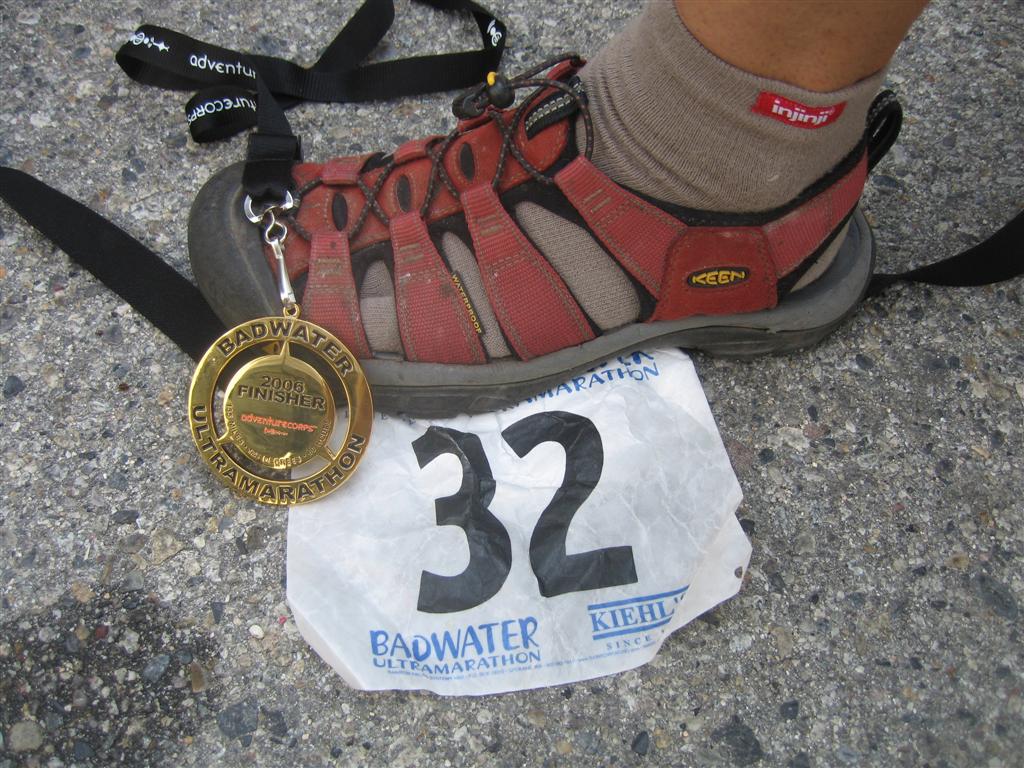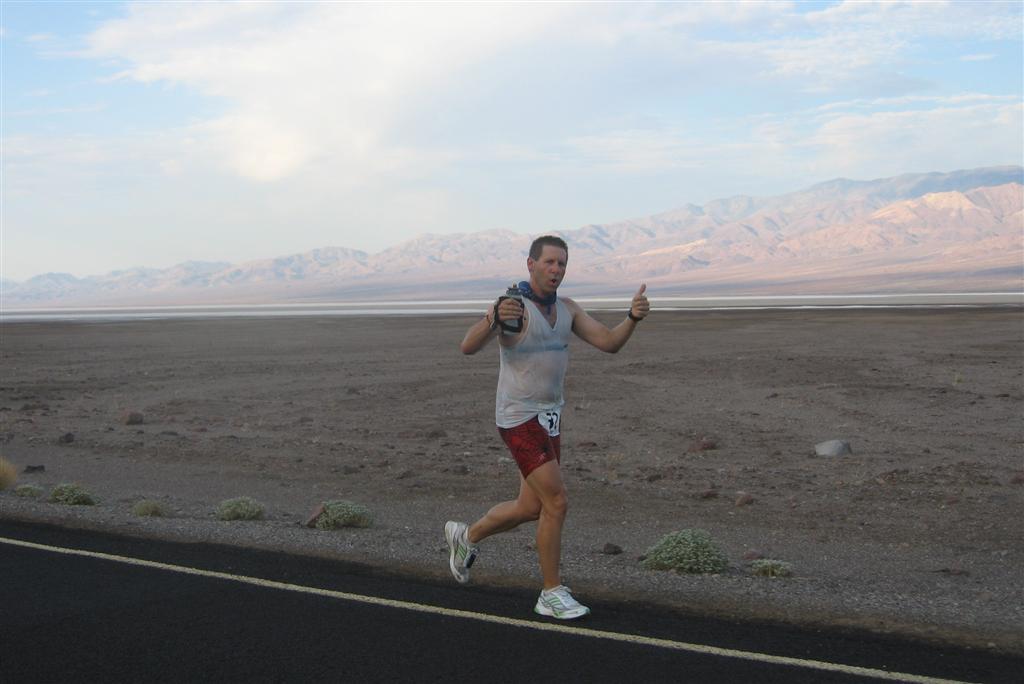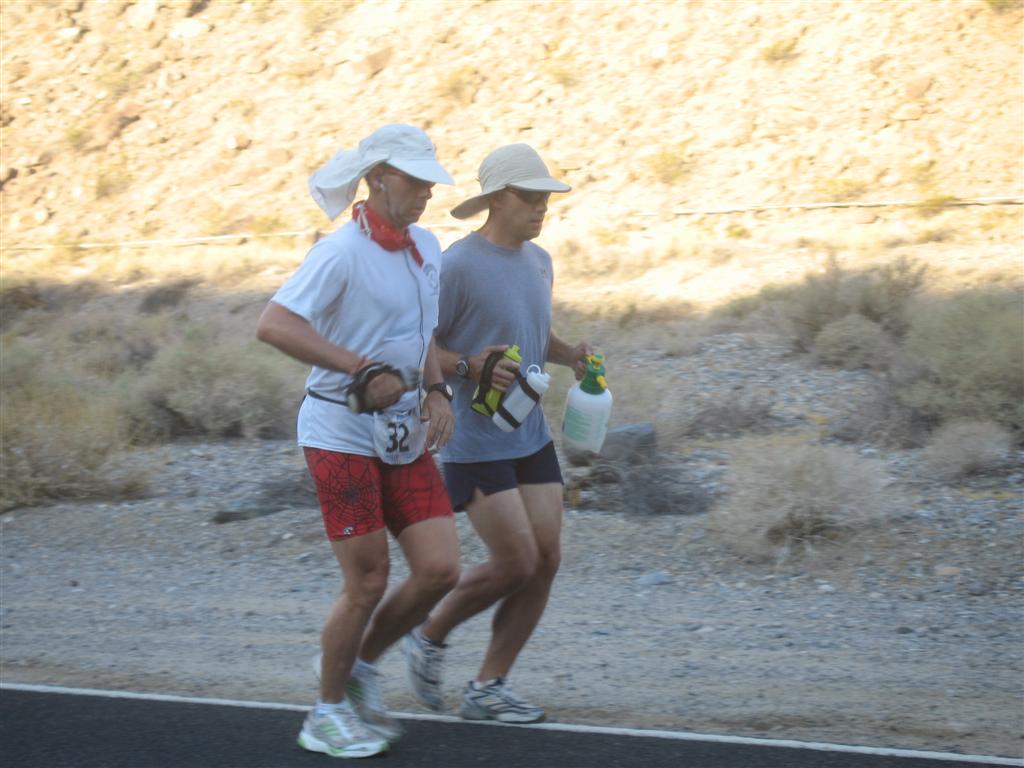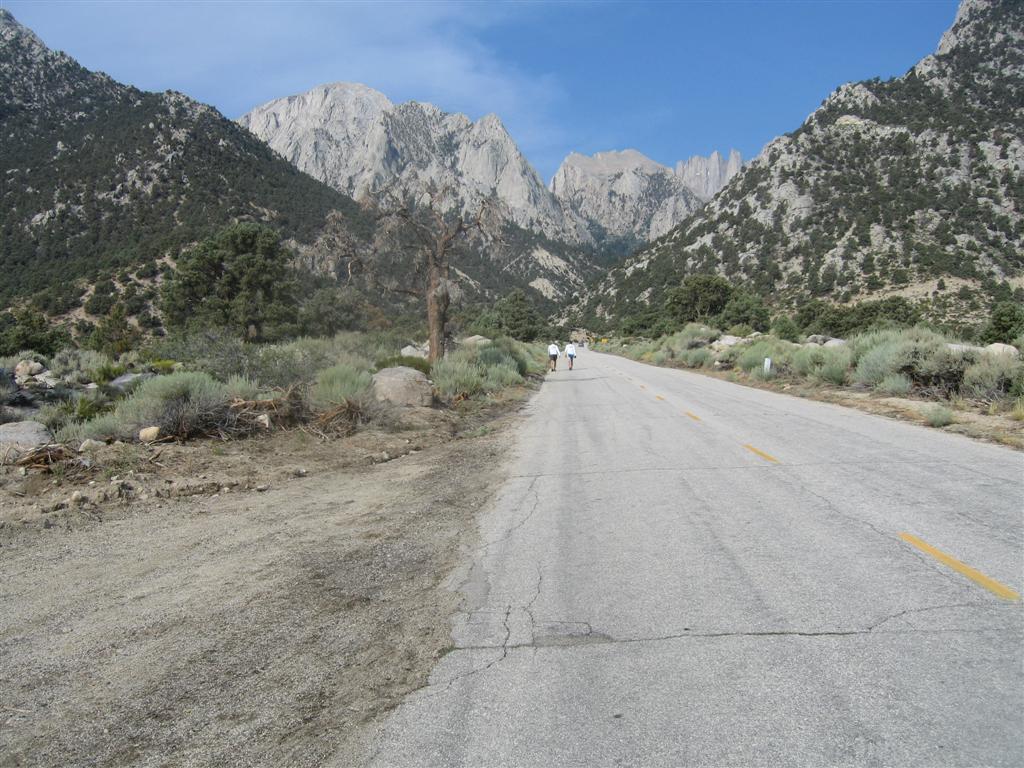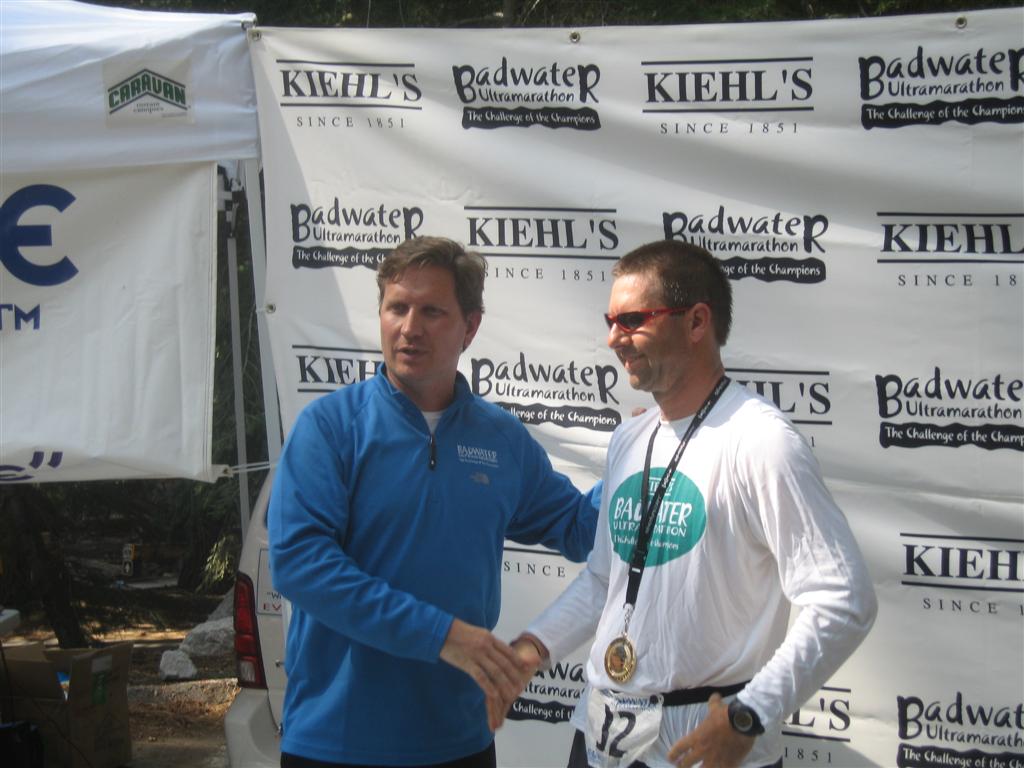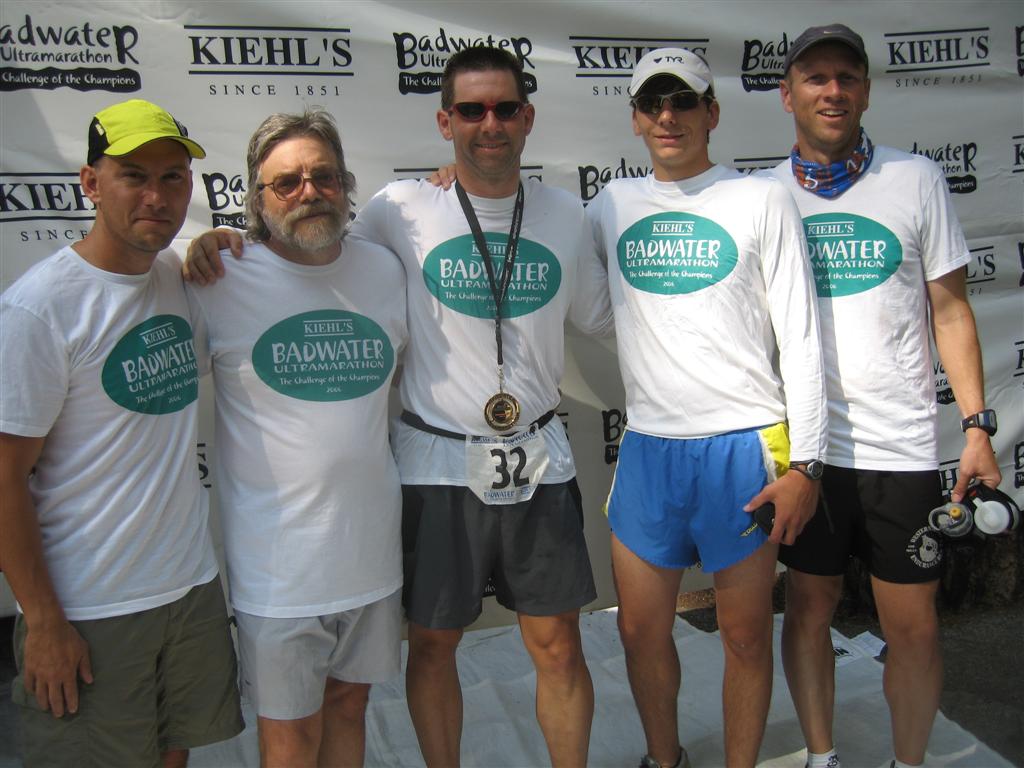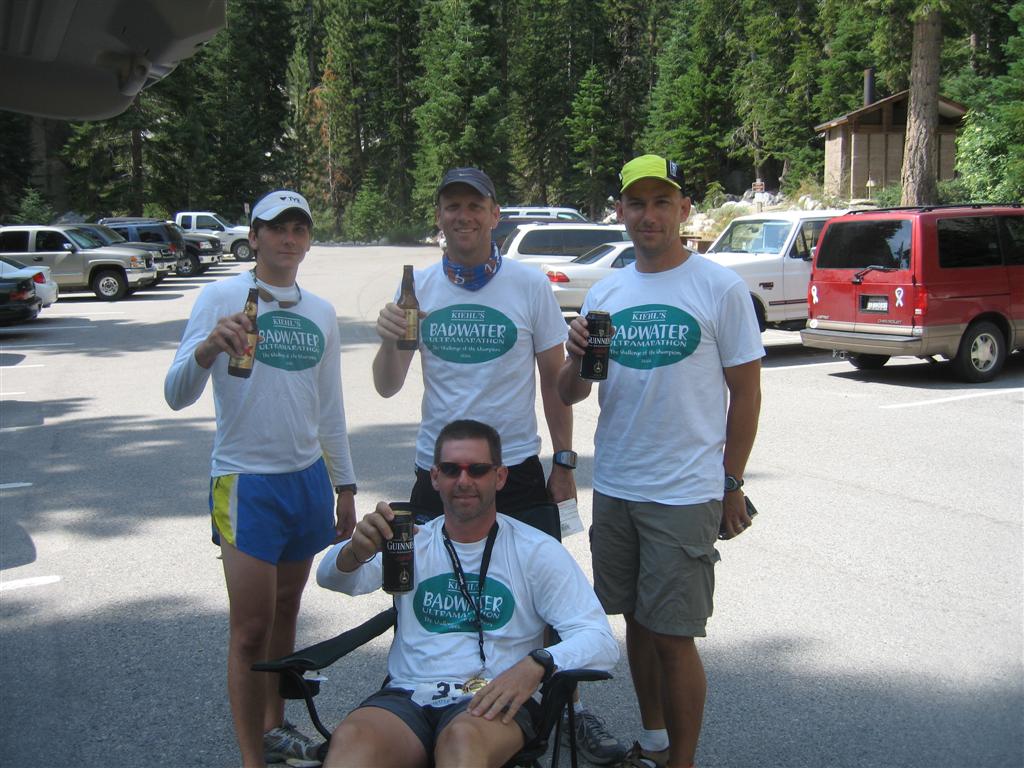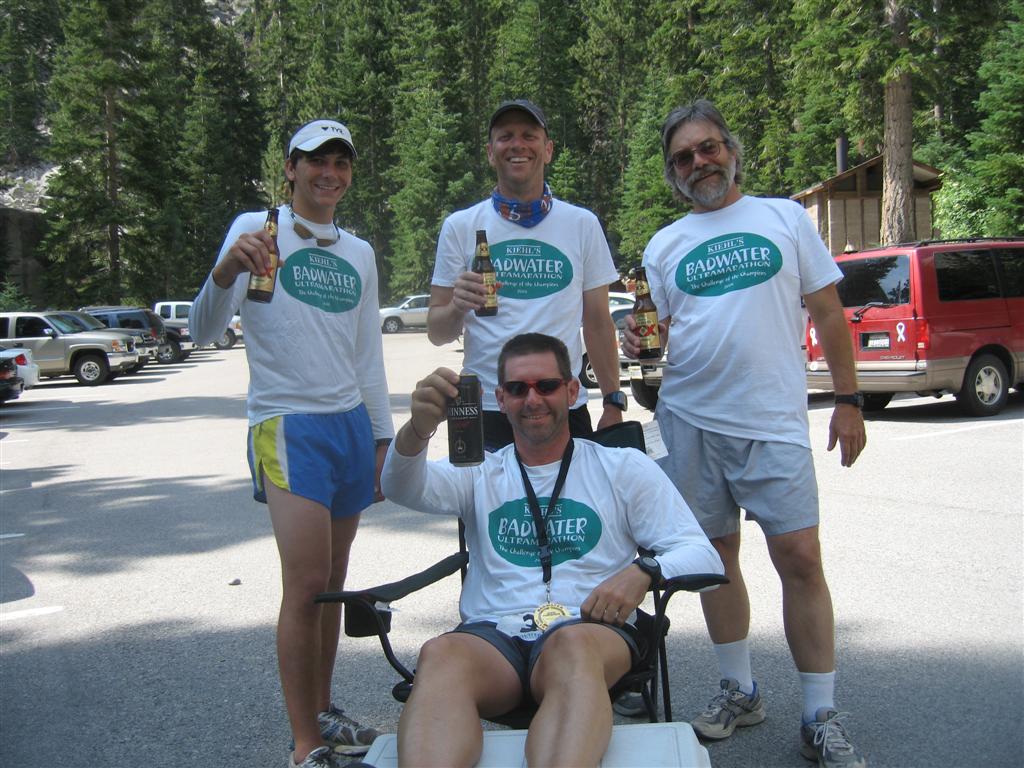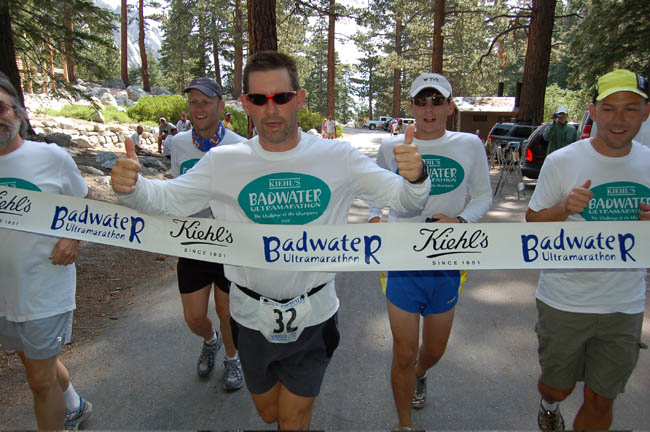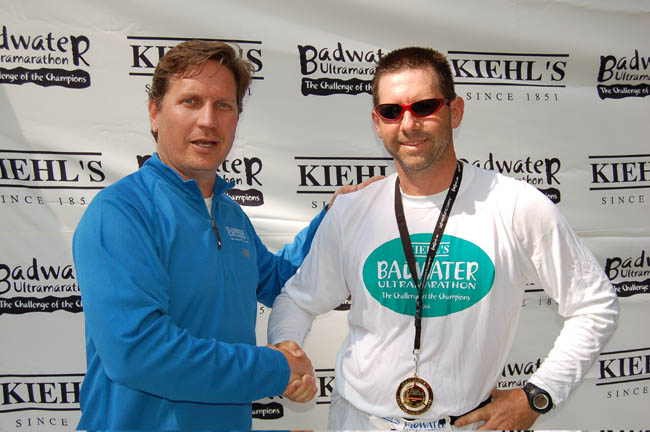And prepared for those we were. I handled the heat
fine and never was overly hot, my stomach never gave me any problems,
my weight
never varied from loss of fluids, I never crashed from complete
exhaustion and never wasted time resting when I didn’t need it. But Death
Valley knows. She knows better than to use the same weapon twice.
No, none of the problems from 2005 caused me a second of problems,
but in their place, a whole new set cropped up to see how we would
cope. I suppose that’s why we come here.
We had 4 crewmembers and two vehicles with the perfect strategy
to quickly and efficiently cover the Badwater course. PERFECT
strategy. But we didn’t have a plan in place for a broken vehicle 17 miles and 3 ½ hours
into the 135 mile 60 hour race. That completely ruined our vehicle packing,
leapfrogging and crew rest strategy before I was even warmed up.
We thought we had everything we needed
to handle any foot or blistering issues, especially since
in 2005 I had
not had ANY problems with my feet. But it was
40 miles into the race, when we realized that due to the high humidity, my
feet had been soaking wet for hours, and had gone completely soft and started
to blister.
Just as we were beginning the 13 mile climb over Townes Pass out of Death
Valley. Blisters with 95 miles still to run is not a
good thing.
At 80 miles into the race, when my tolerance
for the pain and my weakening condition was putting a finish
in jeopardy,
we had to completely
change our strategy and improvise
a completely new one. But persevere we did.
The day before Badwater, Sunday.
Before leaving for Death Valley and the pre-race meetings
and
registration, we load up with
100 lbs of dry ice and
300 lbs of
regular ice, and enough food calories to feed an army it seemed.. We
will buy 30-40 more pounds of ice on race morning to top
things
off
before
we
head to
the
race
start. |
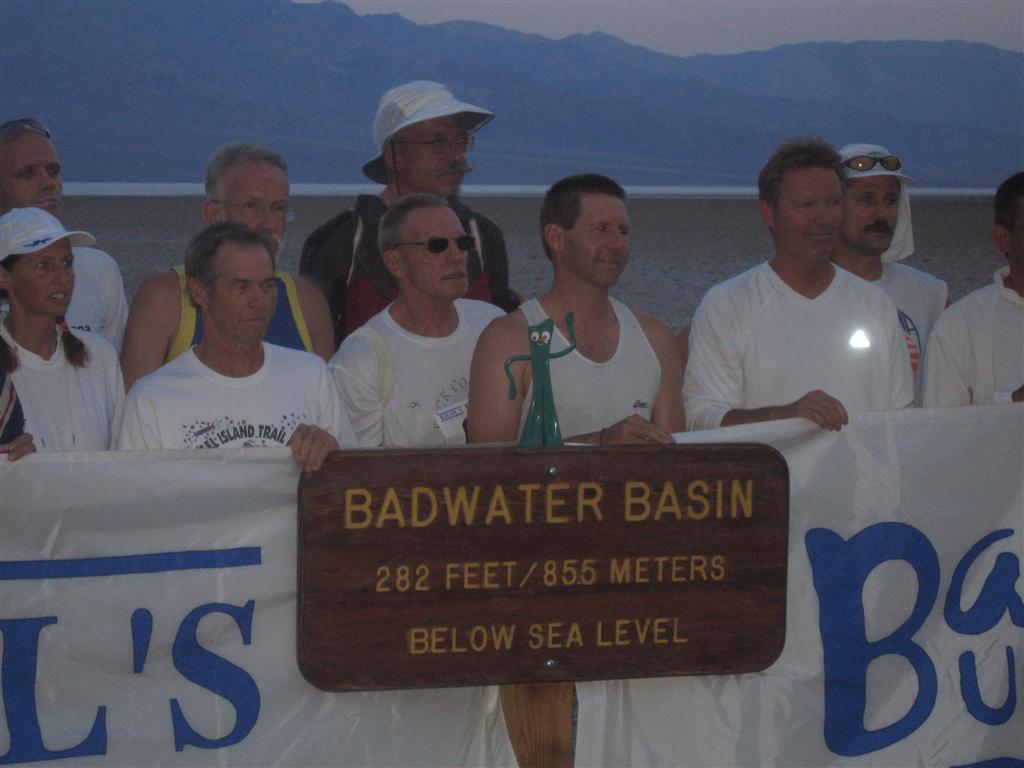 |
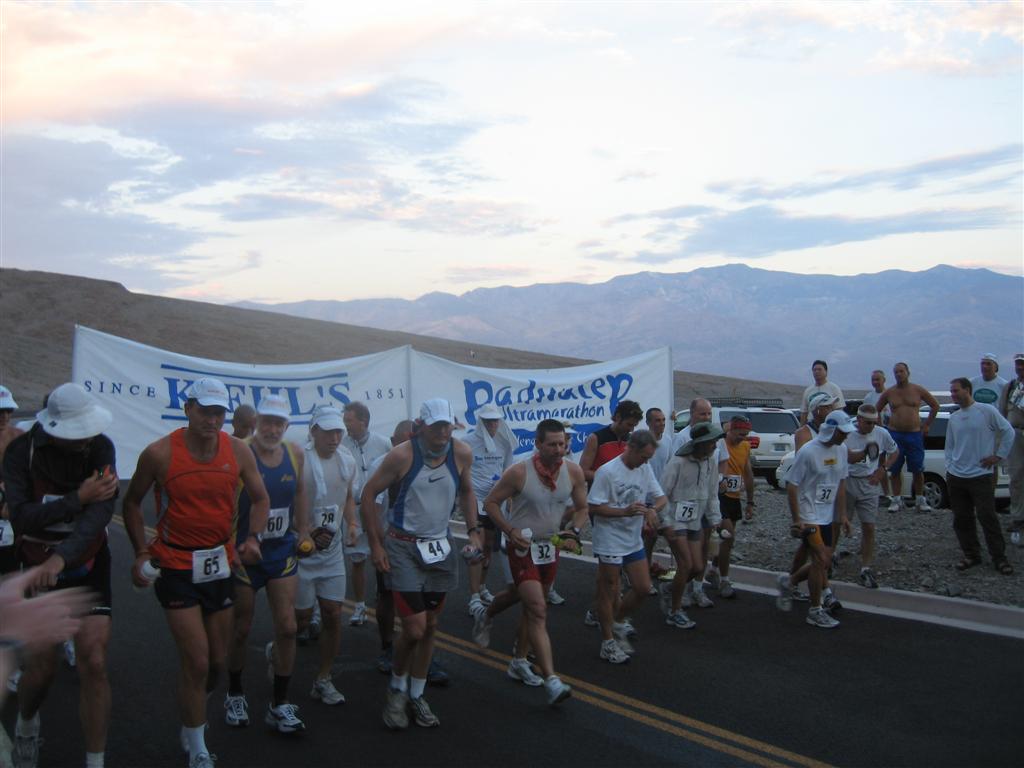 |
On the way to the pre-race meeting in Furnace Creek,
we stopped at Badwater for a few minutes since one crew member
hadn't been there. To see Badwater and the incredible salt flats
and 11,000 foot mountains right beside them. It seemed terribly
hot. Quite a shock to me to be honest, though I did not say anything
to the crew I was quite surprised to feel that way. I had wanted
to spend a few weeks before the race in the desert, but business
commitments just would not allow it. As soon as I felt the heat,
I knew I had possibly made a huge mistake in not spending that
time in the desert. Our electronic thermometer was reading 121-124
at 6 feet off the ground, and 152-154 a few inches above the blacktop.
That is the temperature we are actually trying to perform in during
the race. Even after doing this race twice, I find it somewhat
incredible that it can be that hot.
Our race plan calls for two crew vehicles, one that
will be with me, leapfrogging me every mile or so. That vehicle
has my and the crews immediate needs available. The second vehicle,
has extra food, ice, luggage, and gear for Whitney. It will be
used to re-supply vehicle one as needed and is packed full, with
room for only driver and passenger. After Stovepipe Wells, (mile
42) it will be a rest vehicle for one crew member at a time. That
one crew member will be leapfrogging ahead 5 miles or so, resting
while waiting for us to arrive, and another crew member will then
do the same thing. Walkie Talkies will be used between the vehicles,
and between my pacer the vehicles. Cell phones do not work in Death
Valley, and the only pay phones are at miles 17 and 42, and Lone
Pine at mile 122.
I’ll be taking almost only fluid calories,
staying away from solid food if possible, and going on very little
rest. I intend to go right through Stovepipe Wells, which is a
very common stop and rest/cool off point for many. I think doing
that created more problems for me last year, and even though this
is the part of the course and time of the day that is the absolute
hottest, I do not plan to stop but to simply keep moving. I do
not plan to stop and rest unless I absolutely cannot go on and
need a rest. |
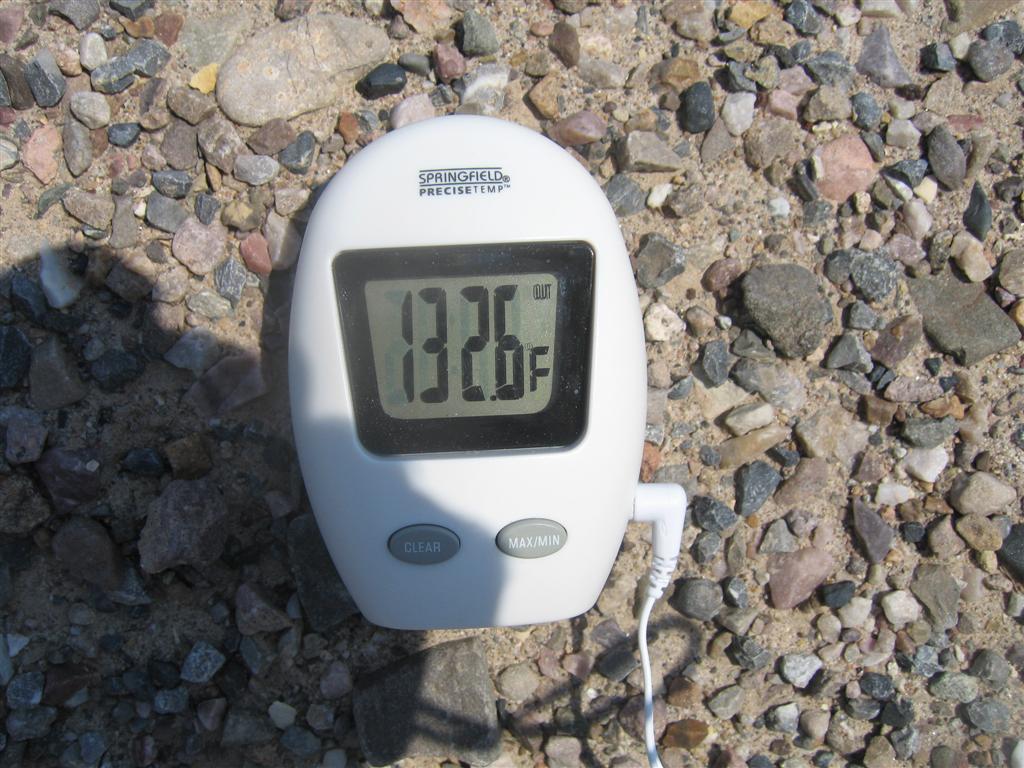 |
Race Start. 6:00am. The first group of 30 of us hit
the road. I am glad to be in this wave. It gives us a cooler start
than the 8:00am and 10:00am starters, and we won’t have the
sun on us for a couple of hours. The downside is we had to get up
VERY early to make it to Badwater by 5:30am. Around 3:30am we’re
having to get up, so I lost a few hours sleep with the earlier start
time. Still, I think it’s better for me, as I am seriously
concerned about my heat tolerance this year. I’ve trained very
hard in Florida for the heat, but it is so different, 90’s
and high humidity vs. 120’s and almost no humidity. The prior
day at Badwater and at the race meeting, I felt the heat, and was
not very comfortable with it. Nothing I can do at this point but
run, drink, and be careful. The start goes well. A group goes off
the front but I maintain a conservative pace. We click off the first
17 miles to Furnace Creek like it’s nothing. |
My pace is good, about 5 minutes slower than last
year. I don’t stop at all at this check station, my crew
checks me in and we continue down the road. It is getting very
hot by this point of the race, and unlike last year, when the wind
was at our back, this time it is straight in our face.
This is the point at which I can begin to have
a pacer running with me, and also where we had left our number
2 vehicle, and would
begin using it to re-supply our first vehicle. The crew stays behind
at this point to make phone calls, get any supplies from the store
and prepare to split up and be using the second vehicle. Brian
starts running with me at this point. Odd thing, when the vehicle
does catch
up to us and gives us our water/calories, it’s the number two
vehicle. I don’t ask anything but keep moving down the road.
Brian stopped to talk with the Tom and William. I don’t see
Vince. When Brian gets back to me, he explains that the van made
some bad noises coming into Furnace Creek, and now will not start.
They have given Brian extra water, and will go back, and continue
working with the van. I don’t like this, being out running
without a crew vehicle close. That’s my guardian angel, I always
have what I need no more than one mile away. Now they are gone, and
will ‘be back soon’. What does that mean? ‘Soon’ may
not mean the same thing to a person who’s been in 120 plus
temps for the last 4 hours as it does to a person who’s occupied
with something else. I can do nothing about it but go on, but I
am very concerned. |
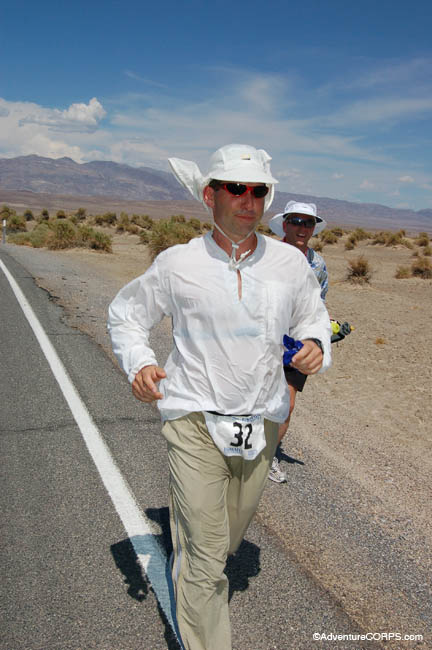 |
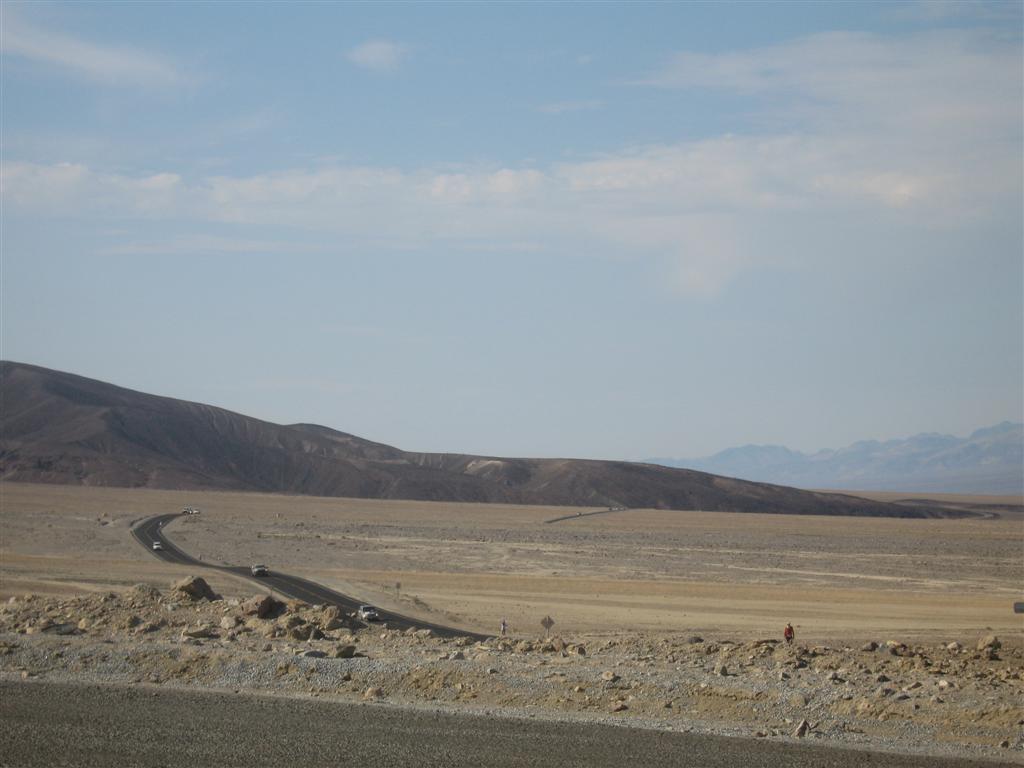
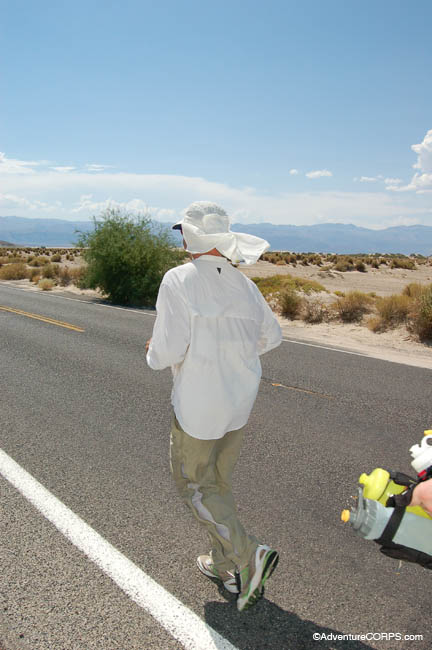
|
They continue a few iterations of this process,
coming back to us, reloading Brian with supplies, then back to
Furnace Creek. Each
time the drive get’s farther for them until it is evident the
van is broke, will not start and is not going to start, and we are
reduced to one vehicle. With all the wrong stuff in the vehicle we
are using, and far too much gear in both vehicles to fit in only
one. Eventually, I am informed that the crew has transferred most
of what we need to the 2nd vehicle, Vince is working with the rental
car company to try to get a replacement vehicle, and will stay in
Furnace Creek to deal with it. Let’s see, 3 hour drive to Las
Vegas, and we are trying to get Hertz to get us a vehicle in basically
the middle of nowhere, ASAP. I am not confident, but it’s not
my job to worry with it now. It’s my job to run. So that’s
what I do.
It’s HOT, the wind has continued to blast directly in our face,
I can feel it, and I’m worried about it, but it’s not
really bothering me. I’m handling it rather well as a matter
of fact. But I remember the brutal heat as I approached Stovepipe
last year, and I remain somewhat concerned about what is coming.
As we make the left turn toward Stovepipe Wells, mile 42 of the course,
I expect the wind would be more of a quartering away wind, much better
than last year. I was wrong, and somehow, the wind was still smacking
us right directly in the face. “Bring it on Death Valley, show
me what you’ve got”, is all I can think. My changing
pacers and myself watched as multiple dirt devils(mini tornadoes
full of sand/dust) danced across the Sand Dunes outside of Stovepipe
Wells. Where we were headed. We’d not had that last year.
All the concerns abated as we got within a couple miles of Stovepipe.
I felt great, was about an hour ahead of last years time and knew
I was going to be able to go right though Stovepipe Wells without
even stopping to say hello. We were going straight up Townes Pass,
13 miles, 5000 feet, and right out of the brutal heat of Death Valley!
Though I had noticed the day before, at the pre-race meeting and
just walking around, that my shirt/clothes were staying more damp
and wet than I remembered from last year, and a few people had
commented about the high humidity, I really did not put the two
together, that this year, sweat and water poured over me were simply
not evaporating at nearly the rate that I was expecting. Last year,
I was dry to the bone ALL the time, though I was heavily sweating
and pouring water over my head, it all dried almost immediately.
This year, I was wet, my shirt stayed wet and damp almost all the
time. I was also being very liberal with the use of water and ice
to avoid any heat issues like last year. What I did not know, was
much of this sweat and water had been finding its way into my socks,
shoes and taped feet for several hours. Ever spend enough time
in the pool to have your feet all wrinkled and soft? That’s
what had happened to mine. Let’s think about this… wet,
soft feet, being slow baked for hours at 150 plus degrees coming
up through the bottom of my shoes, while additional heat and friction
are being created as I run and walk up and down hills. That is
called a recipe for disaster. I just didn’t know it yet.
|
I was about to find out. A mile from Stovepipe Wells, I feet
a blister on my heel, and what feels like a piece of rolled tape
under
the ball of my foot. I don’t want to let these things go,
so we stop to remove my shoes and socks and check things out. To
my
surprise, I am soaking wet, the tape on my feet is wet, my shoes
are wet, my socks are wet. I have blisters forming on the balls
of both feet, on both heals, and on the ends of a few of my toes.
It
is obvious I am going to have to remove the tape and put on dry
socks, but I stay with the same shoes. They have worked great in
training,
and do feel good on my feet, though are maybe a little tight at
this point. I assume if I can protect them from getting wetter
and they
will dry quickly. We move on through Stovepipe an hour faster than
last year, and go straight to the climb up Townes Pass. That is
13 miles and 5,000 feet, and a few hours of continuous climbing.
Soon after, Vince arrives, in a newly delivered
van from Hertz. WOW! He’s remarked the van with my name/number,
transferred everything that was in the old van to the new one and
caught up with us. HERTZ,
is now my official rental car company. In 4 hours from call to
delivery, they arrived with a flatbed truck out of Las Vegas, in
the middle
of Death Valley, with a replacement vehicle. What a disaster this
could have been to my race, in fact had I had only one vehicle,
or only two crew members, or had broke down somewhere else, it
likely
would have been the end of my race right there. Vince was there,
and talked for quite a while with a woman(not in the race) who
had rented from Enterprise, and had her vehicle break down the
day before,
on Sunday. She was in tears and still waiting (on Monday)in Furnace
Creek for a replacement when Vince drove away. Thank you Hertz.
We do have a problem that now we have things in BOTH vans we need,
and
our pre-race organizational efforts are for naught. We will pretty
much have to keep both vehicles with us from this point forward.
As the hours and miles go by, it seems to me that every time one
of the vehicles leaves for some reason, I need something that is
in the vehicle that is gone. It’s probably not as bad as
I remember, but that seems to be an irritating point and I grow
weary
of hearing, “it’s in the other vehicle”.
As we continue up Townes Pass, going uphill for
such a long time always puts a different set of stresses on the
body, everything
is more difficult, heart-rate is higher, sweating is more profuse,
perceived
exertion is higher, AND in this case, it just accelerated heat
and friction in the bottom of my feet as I pushed off with every
stride.
I was building blisters that would cover the front pad of both
feet, much of that being under already calloused skin, putting
them deep
in my foot.
The second challenge that hit us straight in the face about an
hour out of Stovepipe Wells was the wind. I don’t know how
hard it was, 40 miles an hour? 60? It was truly incredible, and
reminded
me of the hurricane winds we’d had at our home in Clermont
last year. In a run back into Stovepipe to make a phone
call, the crew said the resulting windstorm around the Sand Dunes
at Stovepipe had the place engulfed in a sand storm. I was leaned
into the wind and up the hill so steeply that I would have fallen
flat on my face had the wind not been supporting my weight. I actually
felt very good at this point, and was powering up this climb. I
almost felt like Death Valley was making one last attempt to stop
me before
I left, and as hard as it was, I was relishing this climb and loving
every second. I had beat the heat, and was on my way out of Death
Valley. The top of Townes Pass, and the decent into Panamint Valley
await. Scott Jurek, the eventual winner caught me in this section.
I slipped in behind him and drafted for about a ½ mile.
He did not seem to be having much fun.
As day turned to night, and I got higher up the pass, I realized
how truly tired I was. There was no way I would be able to stay
awake for a full 48 hours. In preparation for Badwater, I had avoided
all caffeine for the month of July, so I could get maximum effect
when I used it. But even with that, I needed a break. At this point,
I stopped for my first rest, instructing the crew to let me sleep
one hour and no more. They swear they did that, but it felt like
about 1 ½ minutes to me.
In my exhaustion, I was continually paranoid and questioning the
crew as to whether they were actually giving me the right calories
and electrolytes. I was continually thinking they had forgotten,
or were doubling up on things. After the race, I was able to see
their logs and realized how precise and on target they were with
everything they had done. They did such a good job.
After the rest, we were back on the road with Tom pacing me,
and within a couple minutes, I was feeling very good and could
tell
the rest had a positive effect. We continued to the top of Townes
Pass, and began the long descent into and across Panamint Valley.
Unlike last year, when I had to cross Panamint valley and
the dry lake bed in full daylight and Death Valley like temperatures,
this time it was still night. We arrived in Panamint at dawn,
23:35 hours into the race, and 8 hours faster than I was there
last year. By this point, I was very tired, my feet were really
bothering me, and we needed to regroup for the next 63 miles.
I took advantage of a room reserved for runners to use, to
take a quick shower and get into some fresh clothes while the
crew ordered breakfast. At this point, my fluid calories were
doing well, but I was ready to eat something. I ate some eggs
and bacon, but the pancakes did not appeal to me.
A little more rest here, and we left Panamint Valley for the
several miles and few thousand feet of climbing, up to Father
Crowley’s point, back to 5,000 feet and eventually out
of Death Valley National Park, then down into Owens Valley.
I was moving very well as we left, running when I could, walking
as the incline became too steep. But within an hour, my feet
were causing so much pain, I could not really take a good stride.
Every step was becoming excruciating, and I had 60 miles to
go.
|
 |
This was the point where I began to seriously consider that
I may not want to continue this effort. Up this climb, we continually
stopped and re-taped my feet, changed my shoes, changed my
socks, tried double socks, cut up my shoes to try to provide
relief, cut the insoles of the shoes, cut holes in them where
blisters were, used superglue to hold things in place in the
shoes. It seemed an endless process of trying something, getting
on the road for 100 yards, stopping to change that and try
something else.
We were just trying everything we could, but the bottom line
was, my feet had swollen, I had very large blisters all over
them, and none of my shoes were going to work for me. One crew
member took the van back on the course to find Gillian of the
Zombie Runner company , who probably knows more about foot
and blister care than just about anyone, to come see what she
could do to help me.
I knew there was nothing they could do. I have seen Gillian
and Denise Jones both do foot taping, blister care, I’ve
read the books, and have tried many products and taping methods,
and I knew what we had done was very good. But my weight is
on the bottom of my foot, and that’s where the blisters
are, with the additional tape and foot swelling, my shoes are
really too small. I know there is nothing to be done but suffer
through this, or stop. By the time we reach Father Crowley’s
point, I have been reduced to a very slow pace, I simply am
moving so slowly that I know I won’t make my 48 hour
target, but very probably can still go under the 60 hour race
limit.
The issue I’m having, is WHY? I am desperately looking
for a good reason to continue suffering like this just to say
I finished Badwater. Billed as the toughest run in the world,
it is a great accomplishment to finish, but I’ve done
it before already, I know I CAN do it, I’ve done it.
I’ve completed five 100 mile (or more) races already,
why do I have to do six? What is there to prove? I think about
my kids, and my speeches to them about not quitting, I think
about my friends who’ll ask how I did, I think about
all the people that are watching on the web, I am HAUNTED by
those words I wrote in an e-mail that was distributed to a
few hundred people. In that e-mail I wrote “…But
not because it’s hard, never quit because it’s
hard, getting through those difficult obstacles is what makes
you great, it’s what makes you proud, it’s what
inspires others. It’s what they call character. Embrace
those difficult times, they make the success so sweet. Live
your life to the fullest, it’s the only one you’ve
got!”
|
| Oh how I regretted having sent that e-mail and writing those
words that flowed so easily as I sat in my air conditioned
Florida home! But I also knew, in my core, I knew the whole
reason I do these crazy races because I LOVE being put in that
situation, where many people would quit, and I choose to continue.
Many people do so called challenging events with little
question of the outcome. We all have our own motivations
and reasons for doing these events. I have many reasons,
much of it is I really love participating in the endurance
sports, sometimes I’m racing to see how fast I can
go over a short distance, sometimes I’m looking for
a challenge just to see if I can do it. Mostly it is
simply
a personal challenge and quest to see what I’m made
of, and to try and experience new things. I was not born
with the natural talent to be a great endurance athlete,
and will never win a race like this. The best I ever do is
place 2nd or 3rd in my age group if the race happens to have
some such designation, and that’s only when I run very
well( and not a lot of other racers show up :).
My first 100 mile race was intentionally the oldest and
most prestigious mountain trail 100 there is, with 18,000
feet of climbing in the Sierra Nevada Mountains. I had no
idea whether I could really do this, I’d never even
seen mountains that large when I entered, much less tried
to run in them. I didn’t do any ‘easeir’ 100’s
to prepare myself, or spend years working my way up a ‘ladder’ of
increasing difficulty. It wasn't a quest to see if I could
become a great 100 mile runner, but a quest to see if I could
finish the most challenging 100 mile race. Following that,
the next step up seemed Badwater. I had no peers that had
run 100’s
to follow their footsteps, to compare myself to or to learn
from, though I did meet and learn from many as I prepared
for my first 100. I did much the same thing as I did my
first Ironman triathlon. I didn’t
actually know anyone who had finished an Ironman, I set the
goal, prepared the plan, and completed it. It is a different
situation when you are breaking new ground for yourself.
It’s
different to go where you’ve not been and you don’t
know anyone else who’s been there, and to do it knowing
failure is very possible, and even a likely outcome. But
that attitude is also what has helped me so much in other
parts of my life. To be able go without
the safety net, to
step
out, set the goal, face your fears and move forward. I’m
proud of having developed that ability in myself, but it
is still a great challenge at times to do the right thing,
to do what you know you expect of yourself.
The well wishes that had come back to me from my e-mails,
so many had told me good luck, had passed along ‘all
of their non-quit-ed-ness’ as one good friend wrote
me, were watching via the web and my wife’s communications,
I had to go through that list of people in my mind and think
of the e-mail I’d send to them to explain why I quit.
I’d
crewed a Badwater attempt before, and seen the great courage
of
that
runner to continue on to the finish, I was wearing the good
luck bracelet that my daughter had made for me, who I would
have to face and come up with a reason that I had quit.
I thought about all of this as I contemplated what I needed
to do in this particular situation. But WHY? I never let
myself ask that question DURING an event, but I was asking
it now. I HAVE DONE THIS ALREADY, I DON’T HAVE TO PROVE
ANYTHING TO ANYONE, I’VE DONE MORE THAN 99.99% OF THE
PEOPLE IN THE WORLD OF ENDURANCE SPORTS. I CAN WALK AWAY
FROM THIS AND BE VERY PROUD OF WHAT I’VE DONE. THIS
IS WAY PAST THE POINT OF HAVING FUN. But I really don’t
think like that, I don’t live in the past, I don’t
live on past accomplishments and deeds, I believe I am as
good as my last race, I believe in finishing what
I
start,
and in doing the best I can. Though many will say 'just trying
makes you a winner', I don't buy that, I believe it takes
more courage to get to the finish line than the start line.
Anyone can start, anyone can "try their best",
the event IS the test, and if you don't finish, you failed.
If you
start
it,
you
should
do a good job, and finish it. If you never want to do it
again, that’s fine, you don’t have to enter again.
That is what I believe and the standard I try
to hold myself to, but that doesn't make it easy. (That may
sound harsh, but it's what I believe, I'll also say, to fail
in an event or miss a target goal is ok. If you've never failed
or missed your goal, you've probably don't really push the
envelope
or
set
very
high goals. I HAVE come up short before.)
I was continuing to wrestle with this problem and the pain
in my feet was continuing to get worse. At Father Crowley’s
Point, I told the crew I was seriously considering stopping.
I just couldn’t come up with a reason to continue for
55 or so miles like this. I was hurting, I was not feeling
proud about going on at the snail-like pace. I wasn’t
quitting yet, but I was letting them know I was seriously
thinking about it. They pretty much understood, three of
them told me they understand, to think about it, they’ll
stand by my decision. Vince didn’t say much, but I
saw in his eyes he was not happy with that. I knew he would
be the one to give me a very difficult time should I truly
decide to quit. He knew me better than the others, we’ve
been friends for 17 or so years. He’d been to my first
ultra and to many of my triathlons. His 19 year old son
William has been to those races also, and was now doing triathlons
and ultra-running events and has seen me finish everything
I’ve
ever started. I think or hope I’ve helped inspire
some of that in him. William has been a great crew member
and pacer in this and last years Badwater. I could see Vince
was not going to let me stop without a fight. But I’m
not to that point now, and Vince saves any of his words for
that time should it come.
|


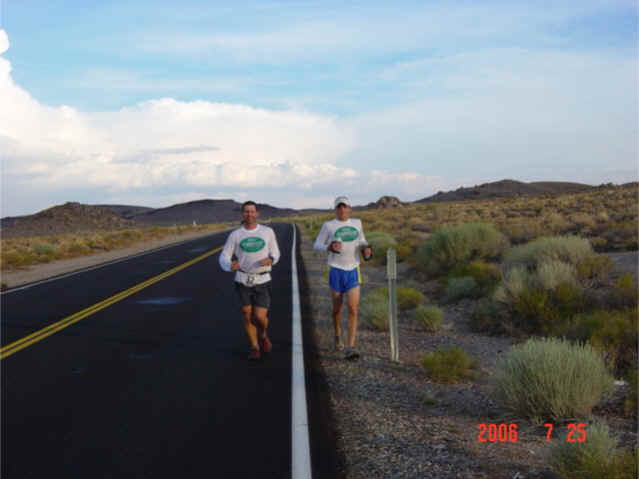
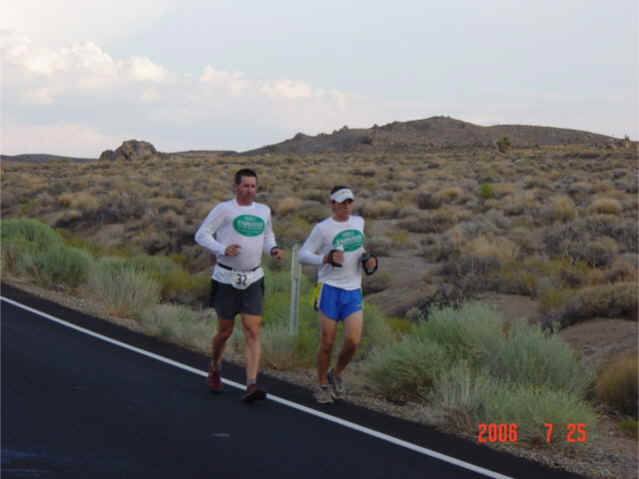
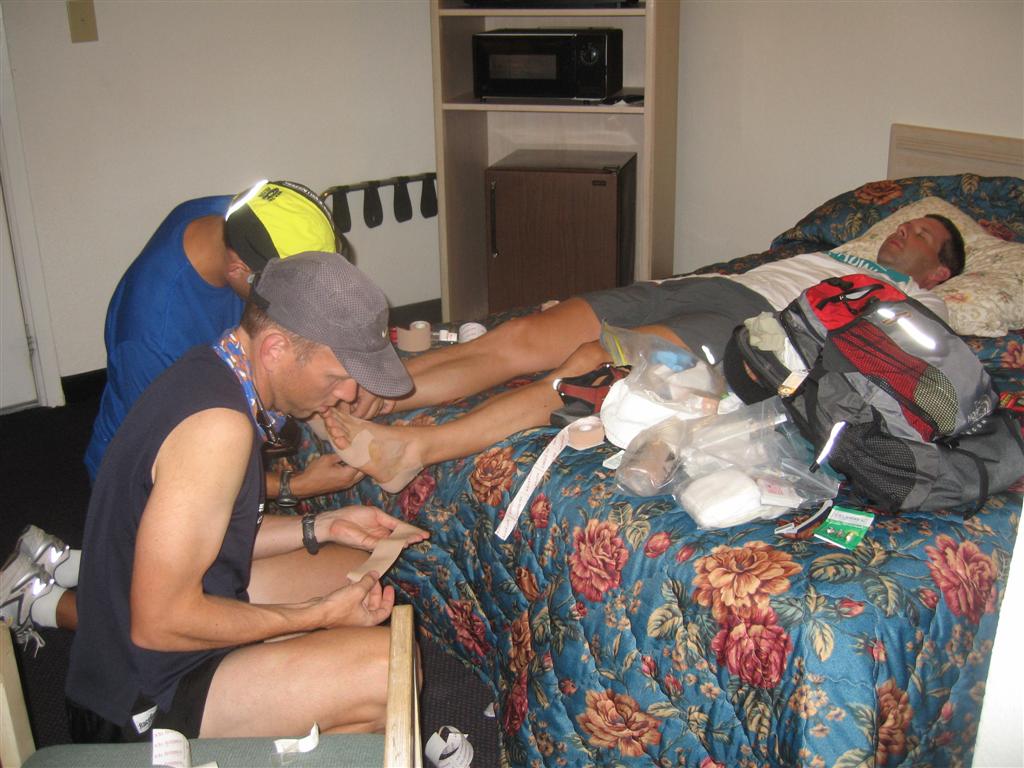
|
| I don’t know who suggested it, but someone at that
point asked about my sandals. What about the Keen sandals that
I had been wearing pre-race? Hmmm. That is an interesting thought.
These are the shoes I wear AFTER all my races, as they have
a very roomy toebox, the bottom has a deep dish that seems
to relieve my sore feet after a race more than anything. In
fact, I’ll put them on as I get out of bed in the morning
for a few days after my races when my feet are blistered or
sore. They are MUCH more comfortable than barefoot.
Of course, they are in the OTHER vehicle, that’s out
doing God knows what, (that is my thought, even though I
know that it’s being used by my desperate crew to find
the ‘blister experts’ to help me with my feet.),
so I have to continue on until the van arrives back to us.
We stop again, and I get them on. Immediately, I can feel
the difference, they are so much better than my running shoes.
I still feel my blisters, and they don’t feel good,
but they aren’t really painful, at least not compared
to what I had been going though. This is great.
My pace gets a little better, I’m 55 miles from the
finish, maybe I can do this. Gillian eventually catches up
to us to check on my feet and possibly re-tape them. I know
I don’t want that as I know the taping on my feet is
very good, but I don’t say anything, I want her true
opinion and if she can do things better, I want her to do
it. We stop and remove sandals and socks and she checks things
out. She immediately states that the tape is perfect, “Better
than I could do” she says. I know it’s not better,
but I’m happy she acknowledges that there is really
no more to be done. She suggests powder would help, and applies
a liberal does of powder to my feet and socks, and we get
back on the road.
I am good for a several miles, but eventually, even the
Keens are starting to hurt, and I am returning to my slow,
painful pace. By this time, we are almost to Darwin, the
90 mile point of the race, with 45 miles to go. I am again
at my wits end, growing weaker, getting tired, and the pain
in my feet has returned. I am struggling again with continuing
for 45 miles at this pace. I am still about 6 hours ahead
of last years time, but am losing that advantage with every
step.
We had sent William back to Panamint for food, and he had
returned with fries and a chicken salad sandwich. He earns
a gold star for scoring this food, as when he arrived at
Panamint, they were shutting down the kitchen as the cook
had apparently walked out, simply quit. A conversation with
the manager as to how important it was to get this food for
me, got him in the kitchen to fix me a sandwich and fries.
What a great crew I had working for me.
As I ate that, I contemplated what I needed to do to finish
this race. I had two main thoughts, one was that I still
had a shot at 48 hours if I could move fast, but that couldn’t
happen the way I was going. The second was that I had little
desire to continue the race if I could not get away from
the pain that was back in my feet, and the slow pace.
Sitting in the van eating the sandwich I made the executive
decision, to put my number 32 marker stake in the ground.
Drive the 45 miles into Lone Pine and get to our hotel. Get
some food, a shower, re-tape my feet in the better hotel
situation, and get a little sleep. I hoped I could take about
3-4 hours to do this, and return to the course with the ability
to actually run. The crew jumped on that idea and all agreed
that was good alternative to try. We put our stake in the
ground one mile short of the Darwin Cutoff Time Check, and
off we went to check in our motel in Lone Pine. I think I
feel asleep before we even pulled the van into the road,
and I slept hard until they woke me up in Lone Pine.
When checking in, the hotel owner asked my status in the
race, we told him were there for a short rest and would return
to the course. In his Indian accented English, he was adamant
that I MUST finish, in fact, he told me if I did not go back
out and finish the course, I would not be welcome to stay
in his hotel again. It was quite funny, and I promised him
I would return to the course and complete the race. He continued
to tell me “You must finish, you have time, short rest,
and you go back out and finish, if you don’t finish,
you will not be allowed to stay here again, you have time…”.
|
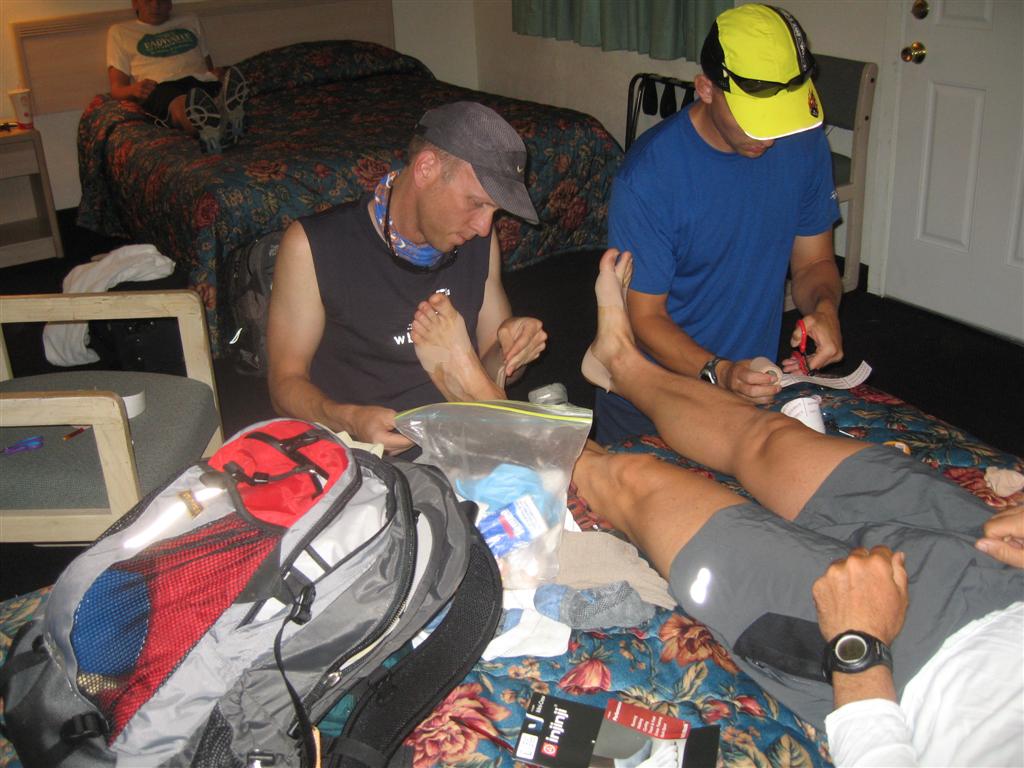

|
Three hours later, shower, food(double cheeseburger,
a large fry and large coke), rest, re-taped feet. We began
the drive back to my start point. I cannot believe how far
it is. I slept when driving in, so didn’t see all of
this, but my gosh, we drive forever. I’m intimidated
as we go along, see other runners and walkers, and just keep
going and going, eventually getting back to our start point.
I am now looking at this as I have a 45 mile race, and if I
can push it, possibly still have a 48 hour finish. I believe
I can do it, I feel pretty good. I immediately go into a very
easy jog. William is with me, he keeps having to transition
from a fast walk to a slow jog. It’s an awkward pace
for him, and for all my pacers as they join me, but it’s
a running pace that I can maintain. I am right on the bubble
as far as 48 hour time. I HAVE to keep exactly the same pace
I am going to hit that mark. I know how long the last 13 mile
climb to Whitney Portals will take, and I know I don’t
have a second to spare. I also know that doing the additional
11 miles to the top of Whitney is now out of the question.
Regardless of how I feel or how strong I am, I cannot do those
trails wearing sandals, and nothing else can go on my feet
at this point. I’m fine with that, Badwater is the race,
and I really want to get it done.
I do feel good, I am racing now, not just surviving, the
decision to give up 3-4 hours for the trip to Lone Pine was
a good one. I run continuously for 20 miles, not really even
stopping for nutrition, I just grab it and go. The crew is
pumped and we are moving well, but we also are right on the
bubble, and eventually slowly slipping behind the 48 hour
pace I need. Between 20 and 25 miles of running, and again,
my feet start to grow worse, and my legs start to grow weary.
I have to take some walk breaks, which are actually harder
on my feet. But when I try to run, my legs don’t want
to go. It is a vicous cycle that I can do little about, but
to accept the fact that 48 hours is out of the question,
the next mark is to go faster than I did last year, 52 hours
and 41 minutes.
|
| At one point, as Brian and I approach the crew vehicles in
the night, it is eerily quiet. Not the usual activity, questions
of what we need and preparing my water or food. We get to the
vehicles to find everyone asleep. That section, I also was
exhausted and in fact, I had been closing my eyes, going 10
strides, opening them to see where I was, then closing them
again for 10 more strides. I literally was falling asleep on
my feet. We decided to take a 30 minute sleep break, we all
needed it. If there were any question of 48 hours, this would
be the end of those thoughts.
Still, I am happy with what we’ve done. We made some
tough decisions and we made a very serious run at it. That
is all we could do. I ran for 20-25 miles without a stop,
which is mile 89 to 115 or so of the race course. I’m
impressed with that, and I’m pleased at the effort.
The crew was uplifting and also proud to make this attempt,
as opposed to just surviving at a terribly slow walk for
the 45 miles to the finish.
We do the best we can as we arrive at Lone Pine, and I get
a renewed energy to try to get to the top as fast as possible.
I was just under 4 hours last year for the climb to the 8,300
feet Whitney Portals. I attack this climb with a lot of running
as we leave Lone Pine. Strong headwinds blast us again as
we move through this section. Almost the whole 135 miles,
that has been the theme, there has been a very strong headwind
directly in our face. I don’t care, and in fact I think
it’s a fitting end. I want this course to give me all
it’s got. I’m going to do this, and I want to
finish strong. Tom comments that he’s worried about
getting dropped. I know that’s not really true, he’s
a great runner, but it makes me feel good that he’s
impressed with the pace and I am running faster than I have
since very early in the race. With William and Brian, I continue
to push, and I hear their breathing. I know I’m moving
well. The grade get’s steeper, just as Vince says he
wants a turn to go along. 100 yards later, and the pace is
too fast and he has to get back in the van. Vince is not
into this endurance crazyness, and it’s not fair to
expect him to do this, but again, after 130 miles and two
days on my feet, it feels good to be able to set a pace that
someone else finds difficult. Besides, Vince’s job
in this event is as a sprinter to go for the beer at the
finish and get it to me as quickly as possible. I want him
fresh for that important task.
We climb and climb, several thousand feet, and incredible
views from whence we came. As far as we can see, and farther
was the start point. It all sinks in at this point that I’ve
done it. That WE’VE done it. A team of five, that endured
a broken vehicle, miles and miles of brutal headwinds, unbelievable,
furnace-like heat, taping, re-taping, re-taping, re-taping… of
my feet, long drives for food or rest, and two days on about
2 hours or less sleep, all of that without an a cross word
between crew or between runner and crew.
|
 |
 |
But we’re there, the last few switchbacks to the
top. We all cross the finish line together, all smiles, a
few photos,
a finishers medal and congratulations, and a story to be
remembered.
People that can’t believe I went 55 miles wearing sandals.
A short(actually it felt pretty darn long) walk back down ¼ mile
to our vehicles and a few very cold beers. I was correct when
I wrote “Embrace those difficult times, they make the
success so sweet.” They do, all those thoughts of WHY?,
of rationalizing that I didn’t need to finish this race
that I’ve started, all the excuses and plans of what
I would say when people asked how I’d done are now gone.
I don’t have to worry about any of that. My crew came
through, and I came through, and I’m better for it. There
is something very special about going to the brink of endurance,
and continuing. I simply do not have the words to explain it,
except that I love it, and I’m proud of it. I finished
about an hour faster than last year, and did the final stretch
in exactly 4 hours. Excellent.
Thanks to Tamara and my children for putting up with me
and being proud of what I do, and to Vince, William, Brian
and Tom for sharing the experience, the suffering, the success.
As we drive down the mountain, back to our hotel, we cheer
for those that are still coming up the mountain. We are pulled
over twice by friends to give me bear hugs and congratulations,
one that lives out West and missed me at the finish, and
another from Florida that just happened to be out there mountain
climbing. He’d descended the Whitney Trail about 5
minutes after my finish, and was coming down to try to catch
up with me. What a great way to complete the journey.
Back home, I’m recounting the story, collecting the
photographs, and turning the 2006 Badwater race into another
little piece of my past.
SEE UPDATE TO REPORT
AT BOTTOM OF PAGE
|
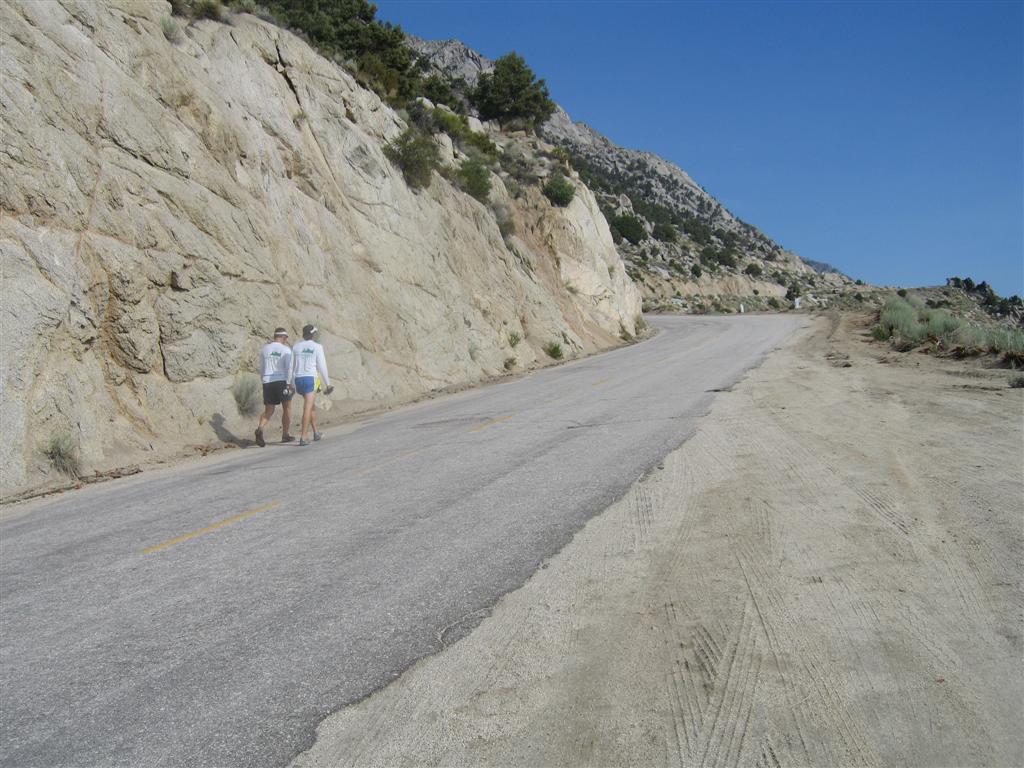
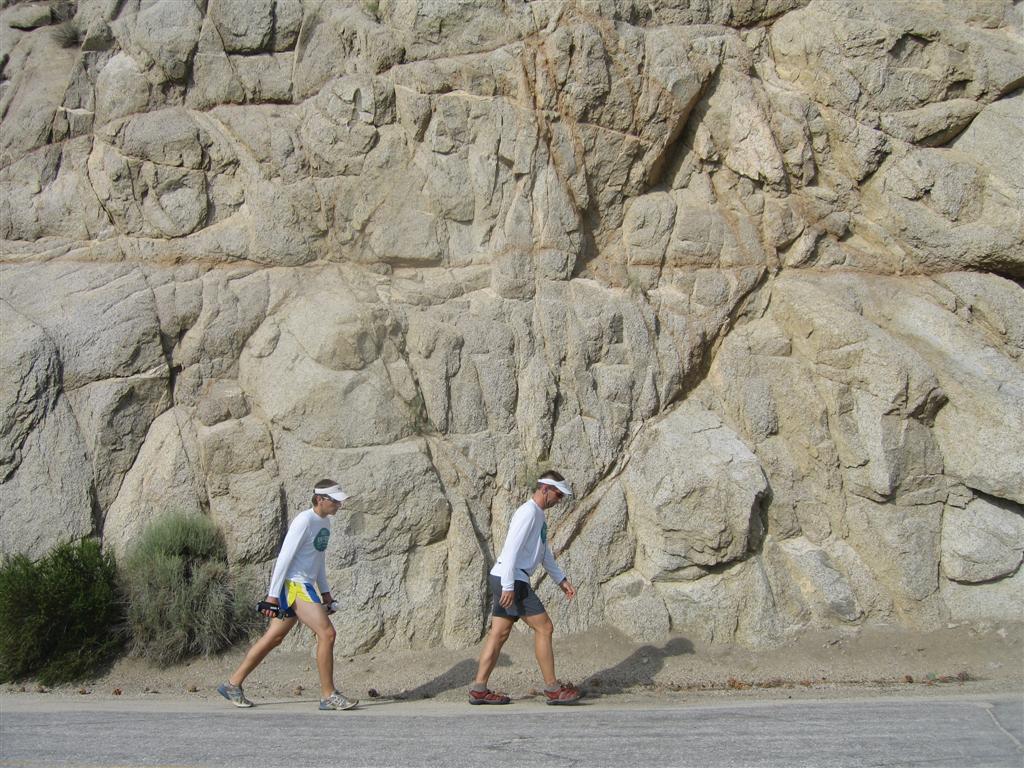
|
Update to Original Race Report
While my writing in this race report focuses
so much on the adverse conditions, the problems, and the pain of
completing Badwater, there is SO much more to the story that I
do not bother to mention. I do these races with the best of hopes
that
I will meet all my goals with few problems, but I also know by
doing the tough events, I am inviting the unknown, the adverse conditions
and the real challenge of finding a way to continue. I absolutely
love it. If I wanted an easy, sure finish, I’d be running local
5k’s and sprint triathlons.
So while my race report is all about those problems, the broken
vehicles, furnace like headwinds and painful blisters, it’s
really a disservice to not mention the other side of that story.
Death Valley is one of the most beautiful, spectacular places I
have ever visited. The huge expanses of dry lake beds and salt flats,
leading to the base of tremendous mountains. The unbelievable geology,
the absolute quiet, and the brutal heat are something that has to
be experienced to be
believed. The history all around of the TRULY hardy souls who crossed,
worked,
and lived in this deadly part of the world as our country was settled.
It is simply incredible and I feel so priviledged to have been able
to experience it.
What did I leave out of my race report? The great memories that
I will remember from this race, long after the blistered feet are
healed, are those first 42 miles to Stovepipe Wells. I ran so well,
my crew was clicking, I did have worries about the broke van, but
mostly, I was doing what I love, with great friends and 80 other
like minded runners, through some of the most spectacular and extreme
country in the world.
Climbing Townes Pass with what felt like a hurricane force wind,
Scott Jurek coming by and me seeing how long I could stay with him,
my legs feeling strong and I was loving every second of it.
I remember both nights with my crew, turning off our lights and
gazing at more stars than I ever could have believed are in the sky.
It was more white than black. I don’t even remember the count
of shooting stars I saw. I will take my children to see that some
day, I can imagine us laying on a blanket, staring at the heavens.
I remember some point after Darwin, when Whitney was in sight surrounded
by dark thunderclouds, with a few beams of sunlight beaming through
holes in the clouds directly onto Mount Whitney, like God was shining
a great spotlight on it, beconing us closer. We tried to get to
the van to get a picture, but the angle wasn’t the same, it's
only recorded in my memory..
I know I’ll never forget when I got in the van at one point,
and William excitedly tells me “Here’s a song just for
you”, the first words I heard of that song listed at the top
of this page were “Things go from bad to worse -- You'd think
they can't get worse than that
-- And then they do”. I just laughed, “Gee,
Thanks William”.
He backpedals and tells me, “No, No, not that, this part, it's
coming up…”.
Or coming up on the van, and finding the whole crew sound asleep.
Brian and I standing outside shining lights on them to no avail,
they are OUT.
The final 4 hours, climbing the mountain, knowing you have finished
the 135 mile Badwater Ultramarathon, a memory that I’ll cherish
forever. As much as I remember that, I also remember the short walk
downhill, back to the car, and a cold beer. We were all a little
shell-shocked, all we could really say was “We did
it” and
smile.
Or 2 hours after eating enough Pizza to kill a normal person at
the awards ceremony, some of us have to go buy burgers and fries
because we are already hungry again.
So many little things, that made those 51 hours such a special time.
It truly ranks as one of the most memorable times of my life.
An accomplished ultra-cyclist friend of mine, who has shared many
of his experiences on the road with me, wrote this to me… Funny
thing is you will remember things even a quarter of a century later
that you never remembered before about your endeavor; just a funny
little thing or a real big thing, a view, etc., or something that
went into your memory bank, and comes back at the darndest times
but puts a smile on your face.
I hope he’s right.
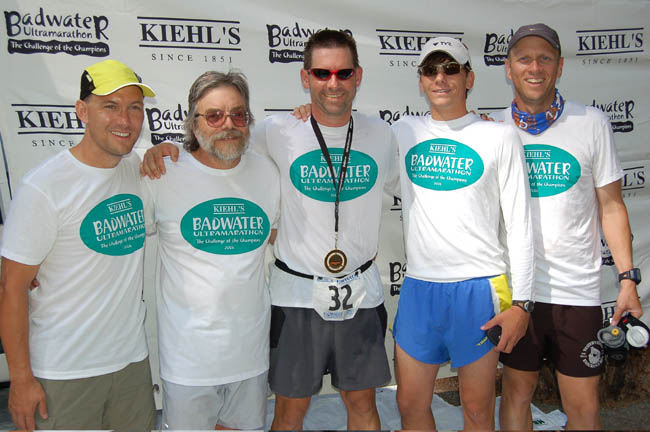
|
|


